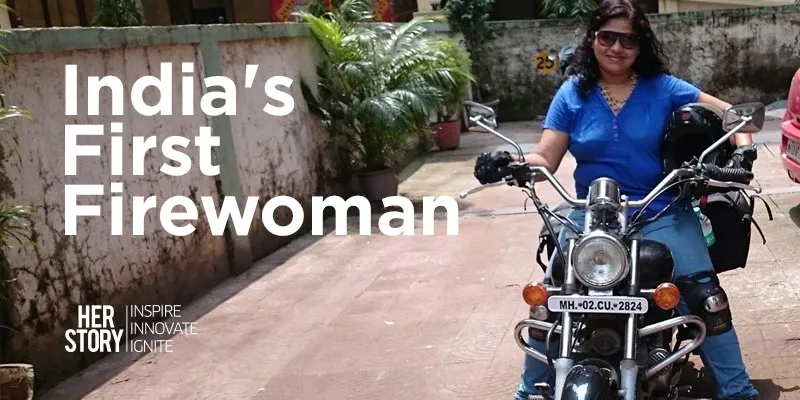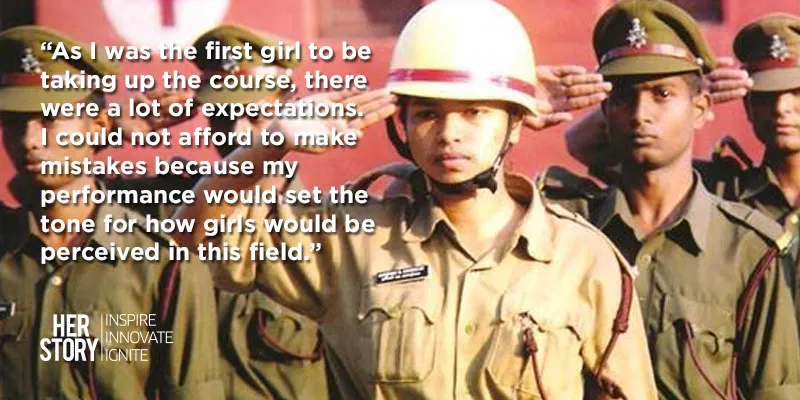What it takes to be the first woman firefighter of India – Harshini Kanhekar’s story
“You play with fire, Harshini, aren’t you scared?” I ask her.
“No,” she chuckles.
Harshini Kanhekar, 37, is India’s first firewoman. She has literally and figuratively broken through walls and ceilings while paving the way for various policy changes in the field of fire service. So how did this young woman, who dreamt of joining the armed forces, learn to fight fires so fearlessly?

Discovering herself
Not too long ago, this braveheart was struggling with fears of a mediocre life, as a young teen studying in an all-girls’ college in Nagpur.
“I did not talk to anyone, participate in competitions, or study. That can easily be called one of the darkest phases of my life” she says.
This was in stark contrast to how she had been while at school. Although not very good at studies, she had always been actively involved in extracurricular activities, participating and winning most competitions.
“I could not allow myself to slip into oblivion. I decided I had to change”
The dream of donning a uniform
After completing her pre-university in Lady Amritbai Daga (LAD) College, Nagpur, she enrolled for a Bachelor of Science degree at the same college. But this time, she started with a completely fresh perspective. Harshini started actively taking part in all competitions and, started winning them too. This made her popular among the students and staff of the college. She had found her mojo again! Around the same time, she joined the National Cadet Corps (NCC).

“This was the turning point of my life.”
The NCC helped her discover an untapped adventurous streak, and she decided to apply for the armed forces. After completing her graduation, Harshini applied to quite a few colleges and courses but ended up pursuing an MBA. Her sights, however, were still on joining the armed forces, and she had simultaneously started preparing for the exams.
She was not very happy studying for the MBA and began applying to various other courses. Around the same time, she applied to a fire engineering course on the insistence of a friend who had learnt about the course through an employment portal.
“The only question I asked my friend before appearing for the exam was if there was going to be a uniform. I had always dreamed of donning one and when she said yes, I wrote the exam and got busy again with my MBA.”
One day, she got a call from her father, who told her a telegram in her name had arrived. It was from the National Fire Service College in Nagpur. She had got through!
“My friend, Shilpa, who had appeared for the exam with me hadn’t got through. A little later, we all learnt that I was the first girl in the history of the college to have made it. It was surreal, that feeling”
Although it was no mean achievement, Harshini’s parents were apprehensive.
“Nobody knew about this college, and what the course was all about.”
The ONLY girl
But they soon learnt that the college was the only of its kind in all of Southeast Asia, and was run by the Home ministry. Harshini had put in a lot of hard work to get through. It was a UPSC style examination with only 30 seats up for the grabs. And soon, she was going to be the first girl to ever study there!

After studying in an all-girls’ college for five years, she was now going to be studying in a college full of boys. It was not going to be easy. The seven-semester course in fire engineering required the students to live in residence, so special provisions had to be made for Harshini.
“As I was the only girl, the college had to obtain special permission from the Home ministry to allow me to go home after classes.”
It was not a regular course that required her to be in college all day. She had to change into different uniforms for each drill and be present in time. While her classmates went to their hostels, which were located on the campus, she had to go home. The schedule was gruelling. But she had to keep at it.
Being a girl in an only boys’ college sure got her a lot of popularity, but it also put her under a lot of pressure to perform.
“All the boys in my college used to ridicule me because of all the media attention and publicity I was receiving. According to them, I was doing nothing different. What they failed to understand that it was not about Harshini Kanhekar, the person, but more about a girl breaking into a male bastion, and doing what no one ever had.”
Related read: How Kajal Singh aka Dizy went from being a shy Delhi girl to one of India’s first female graffiti artists
Dealing with heavy water hoses, suction hoses, and mock drills with dummies, the course was difficult for everybody who was taking it. But Harshini had additional challenges to take on.
“As I was the first girl to be taking up the course, there were a lot of expectations. I could not afford to make mistakes because my performance would set the tone for how girls would be perceived in this field.”
Fearless and raring to go
Her first fire situation was a cylinder blast in Shirdi during her practical year at college, where she was required to work in fire stations. Ever since, she has always been on the lookout for larger fires.
“I always used to ask my station commander when I will get to douse big fires.”
Before joining ONGC in 2006, Harshini has helped douse several big fires in Delhi, Kolkata, and Mumbai. Her longest operation was in Delhi when a tin factory caught fire, and she along with others, had to fire fight for six hours at a stretch. As a part of her service, she has also rescued civilians during floods, building collapses, wildlife attacks, and river swelling.
After joining ONGC, she was posted at the company’s Mehsana station, where she was in-charge of one of the three fire stations. Owing to her bravery, Harshini was also granted access to offshore rigs recently and is currently the deputy manager, Fire Services.
“I am fortunate to have had supportive parents, great instructors, and now, employers who have always stood by me.”
Realated read: One in a billion: Ishita Malaviya goes against the tide to be the first woman surfer of India
Harshini’s success story is a great example for everybody who is looking to do what no one ever has. She has shown us what courage and hard work, when combined together, can achieve. As she continues to make us all proud, she has something to say to the government’s policy makers and management of educational institutions and corporates.
“Don’t assume that any job is unfit for someone purely on the basis of gender. The women of today are flying fighter jets, fighting fire, and doing the unthinkable. It doesn’t imply that we couldn’t do it ten years ago. Ability should only be judged on the basis of qualification and not gender.”










![[Funding alert] Men’s lifestyle brand DaMENSCH raises Rs 122.5 Cr in Series B led by A91 Partners](https://images.yourstory.com/cs/2/ba9e8080834311ec9e7e95cb06cf6856/damensch1-1646024956689.png)
